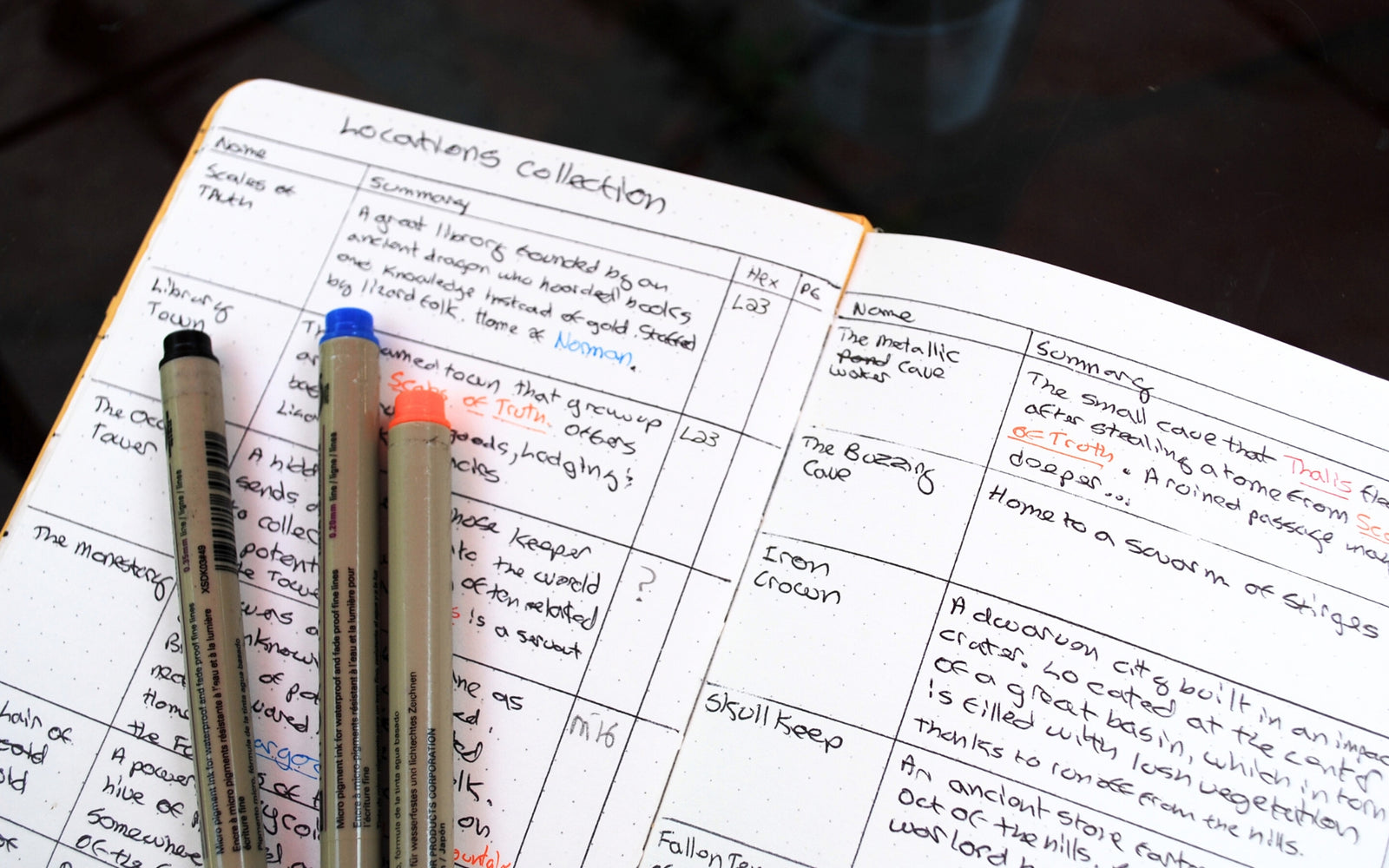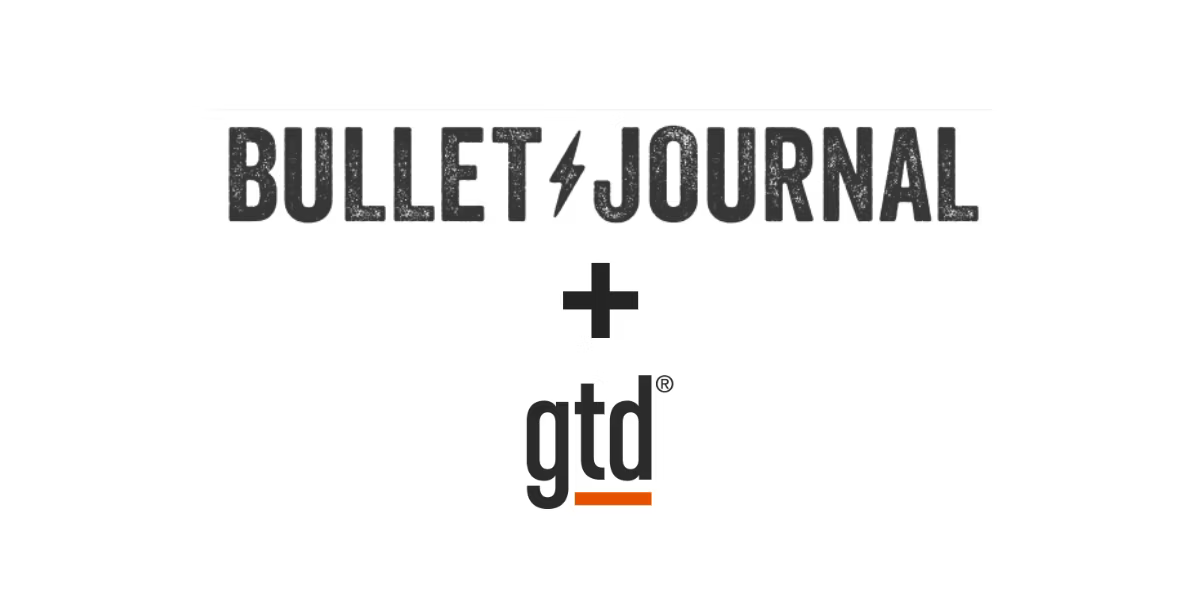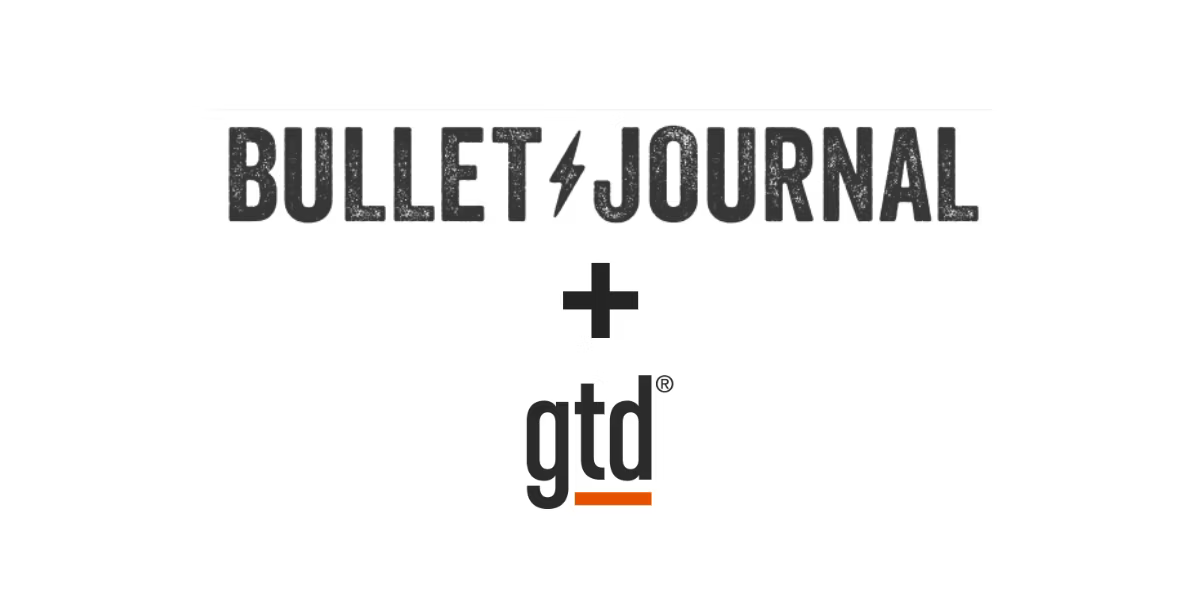A full version of this article was first published on Nuketown.com.
Bullet Journals are analog alternatives to printed day planners, “to-do” apps, and note-taking tools. Created by Ryder Carroll, bullet journals are a purposefully archaic approach to capturing life’s esoteric bits, from a list of today’s meetings to a quick note about that weird dream you had last night.
Though typically used to organize your real-life, Bullet Journals also work well for role-playing games. Just like real-life, role-playing games require individuals to keep track of a dynamic, increasingly complex world. The “meetings” may be fictional (and involve greater use of battle axes and fireballs) than your 3 p.m. analytics discussion, but there can be just as much to plan, note, and review as their reality-based counterparts.
Quick Overview of Bullet Journals
At its most basic, a Bullet Journal recreates print or electronic day planners with annual, month, week, and day collections called logs. These logs capture the dates, tasks, and notes relevant to each time period. A key principle is using one log to inform another. You might lay out the next 12 months in an annual log noting birthdays, trips, anniversaries, and such. Then, when you do the monthly log, you migrate those dates to that view, and then do the same for the week and daily logs.
All that copying might seem like too much busy work and if so, you can ignore it. Bullet Journals are nothing if not customizable. Consider though, that there is value in the copying, particularly if you’re someone who has trouble remembering important dates or keeping track of project milestones. And there is an even greater value in hand copying, which is inefficient by design. It forces you to really read and think about the task you’re copying, rather than relying on software to auto-forward a task to the next day’s queue.
It’s not just dates and deadlines. Each of the calendar-style logs can also be used to capture random thoughts, notes, and what have you. Some use them as an opportunity for creative expression, creating beautiful spreads in pencil and watercolors. They’re impressive to see, but ultimately, not needed … unless you need it.
Complementing these logs are other modules. Habit trackers help you know when you did a thing and are great when you want to read more, exercise more, or complain less. Collections are used to gather like thoughts and notes onto a single page and are good for brainstorming. The index pulls everything together, helping you note where key concepts or ideas show up.
There are more efficient ways to do all of this, but efficiency isn’t the point. For me and others, bullet journaling is a mindfulness exercise that helps you focus on the here and now.
My Approach to RPG Bullet Journaling
Before fully launching into my current RPG Bullet Journal, I went back to the beginning and paged through Bullet Journal creator Ryder Carroll’s website. In addition to providing a basic introduction to Bullet Journaling and its techniques, the blog section includes tons of examples to your own journals.
After re-establishing the foundation, I read Berin Kinsman’s Bullet Journaling for Gamemasters, Revised (Dancing Lights Press). It was Berin who got me into Bullet Journaling in the first place, so it was logical that I turn to his book. The slim tome assumes you have a basic understanding of Bullet Journaling, and leverages that understanding to create a campaign journal. Berin’s approach is straightforward and economical, eschewing the sort of creative embellishments (e.g. watercolor paintings for your monthly calendar) that turn Bullet Journals into art forms. My own approach echos his, but my collections tend to be grids, and I incorporate more color and doodles. It’s a worthwhile read if you’re interested in trying out RPG Bullet Journaling yourself because it gets you thinking about how the tool can best be used with a campaign.
Bullet Journal Friendly Campaign
Armed with knowledge, I still needed a campaign to journal about. It came in the form of my current lunchtime game: a Dungeons & Dragons 5th Edition hexcrawl set on a homegrown science-fantasy world.
Called Scales of Truth, the campaign is inspired by equal parts Conan the Barbarian, Gamma World, and old-school D&D, with a little Thor: Ragnarok thrown in (sound familiar? It may, in fact, be Spellcrash … but I’m not quite sure). We’re building the world as we go, and while I have some idea of what lies over the next hill (or hex), I find I’m discovering just as much as the players are.
As a lunchtime game, played with my co-workers, Scales of Truth runs for one hour twice a week. A typical adventure takes us several weeks to complete. Because sessions are short, I don’t have a ton of in-game notes to record … but because sessions are short, it is important to record them. It’s all too easy for us to forget where we left off, especially if the Fates conspire and we only get in a single session.
My goals for the Bullet Journal:
- Document game sessions with quick-hit summaries
- Identify to-dos for the campaign (e.g. new NPCs, new locations, etc.)
- Brainstorm (and keep track of) non-player characters, locations, magical items, and other key campaign elements
- Embrace messiness: My Bullet Journal can be a mess, with crossed-out words, misspellings, and other mishaps. That’s ok.
Building the Bullet Journal
My RPG Bullet Journal contains a few key artifacts:
- Campaign Overview: A two-page spread summarizing the campaign.
- Player Character Spread: Two page spreads for each PC, capturing the essential elements of each character.
- Non-Player Character Collection: An listing of NPCs, with a brief summary and a note about the page for their full entry.
- Major Non-Player Character Page: A one-page summary of an NPC.
- Minor Non-Player Character Half-Page: Similar to a major NPC, but limited to half a page.
- Locations Collection: An index of locations, each with a brief description and a hexcrawl coordinate.
- Location Page: A write-up on a particular location cited in the Locations Collection and the hexcrawl map.
- Game Log: A six-session, column-based overview of recent games.
- Game Session Log: A one-page summary of a particular session.
At every turn, the focus is on short, concise entries. I have a tendency to over prep for games; the manual process of writing in the Bullet Journal helps me avoid that.
For the Bullet Journal itself, I used a Piccadilly, dotted grid-style notebook. Normally I’d use a Leuchtturm1917 because it’s a little bigger and more durable, but I had the Piccadilly handy. Also, it’s bright yellow, which makes it hard to lose.
I’m not 100% Bullet Journal based for this campaign – I still like to write my adventures digitally – but I hand draw and key my maps whenever possible (usually inspired by the art style of Dyson’s Dodecahedron.
The Hexcrawl
Not actually part of the Bullet Journal, my hexcrawl map is on an 8.5×11″ hex grid, where each hex represents 6 miles.

Campaign Overview
A quick-hit description of the campaign followed by bullets summarizing the setup (e.g. “Set on a broken but healing world”, “Weirdness abounds, strangeness is welcome”, “The PCs shape the world”, “Improvise! don’t over plan”). As I find real-world inspiration, I add it to this page.

Player Character Spread
Usually done over two pages, with a biography, quotes, stat block, notable elements (e.g. things that stand out about the character, plot hooks, etc.), campaign connections (links to other people and places in the campaign), and random notes.

Non-Player Character Collection
A listing-style page with columns for “name” (which includes gender, species, level, and class) “summary” (a sentence or two about the NPC) and “page” (the page number). Notable NPCs get their own page or half-page write-ups, but some may have nothing more than a D&D 1st edition style entry on this page.

Major & Minor Non-Player Character Pages
Major NPCs, those likely to show up frequently in the game or who have a significant role to play, even if they only appear in the background, get a full page. Some might get a two-page spread, but I haven’t done one of those yet.
Each NPC page has a short biography, a note about character inspiration, key stats and skills, notable elements, and campaign connections.
Similar to Major NPCs, Minor NPC write-ups are compressed down to half a page. These are characters who might show up a few times during the campaign – shop owners, caravan drivers, etc.

Locations Collection
The Location Collection includes four columns: “name” (the name of the location), “summary” (one or two sentences describing the place), “hex” (the hex coordinates on the hexcrawl map), and “page” (the page number the location appears on in the Bullet Journal).
As I built out my RPG Bullet Journal, I found this was my favorite collection type. It perfectly complements the hexcrawl format – as I drew the map, I found myself brainstorming features and excitedly adding them to the map and the Locations Collection. I freely admit to having only the vaguest idea of what most of these locations are, but that’s the fun of a hexcrawl.

Location Page
A one- or two-page spread summarizing the location, possibly with a map. The full adventure write-up is usually done digitally via a Markdown editor, but I love hand-drawing maps.

Game Log
This is the most complex spread I’ve done in any Bullet Journal. Across the top are real-world game dates, with six columns spread over two pages.
There are six rows
- Goals: One or two goals for the session (e.g. “Head to the cave”, “test fog of war”, “confrontation with Thalis”). Given that each session is only an hour, I only need one or two goals.
- PCs: A list of the player characters who played in that session.
- Summary: A few sentences explaining what happened.
- Follow-up: A list of “to dos” for the campaign (e.g. “work on hex map”, “setup XP tracking”, “Draw a map. Import it into Roll20. See if it will align [with grid]”)
- Day tracker: We haven’t built a calendar for the game world yet, so I’m simply tracking the number of days since the campaign began.
- Episode: The name of the episode we’re currently playing (e.g. “The Errant Book”).

Game Session Log
A one-page summary of a particular session. It includes a session overview, as well as a “developments” section that calls out things that I may need to follow-up on. There’s also a “campaign work” piece (mirrored in the Game Log) that calls out things I need to do for the next session (e.g. “detail the Kazeal Tome”, “create random encounters list”). I usually take these notes in digital form (e.g. Google Keep) and then hand-copy them into my Bullet Journal. That helps me remember what happened while letting me edit down the content to what’s important.

RPG Bullet Journaling Resources
Getting organized in the real world and getting organized in your fantasy one share similar challenges. There are plenty of 1-for-1 workflows between the two, such as using the various calendar-style logs to record what happened when, plan future events and stories, and quickly record what happened at the table. Plus, many gamers (myself included) already embrace the print aspects of the game, so adapting Bullet Journals to serve the hobby makes some intuitive sense.
Here are some resources I found helpful in coming up with my own approach to RPG Bullet Journaling.
- BulletJournal.com – If you’re new to Bullet Journaling, I recommend starting at the beginning. Stop by Ryder Carroll’s website, read through the tutorials, and check out the videos. Start thinking about which modules might work for you, either for a conventional bullet journal or for your game. You may also want to read “My Approach to Bullet Journaling” here on Nuketown.
- Bullet Journaling for Gamemasters, Revised by Dancing Lights Press – If you have a good Bullet Journal foundation, this short book provides great fodder about how to adapt that foundation to RPGs. It’s fairly conventional in its approach to calendar and day-style logs, collections, and content spreads, but it did an excellent job of getting me thinking about how to adapt standard bullet journaling techniques to RPGs.
- MonteCookeGames: Bullet Journaling for GMs and Players – A short rundown of Bullet Journaling including a discussion about how to pick a journal, campaign and session spreads, and using colored tabs to organize multiple campaigns in the same book.
- Bullet Journals for Game Masters – A blog post promoting the community of the same name on MeWe (the community having previously existed on Google+)
- The Bullet Journal Method, Adapted for Tabletop RPGs Like Dungeons & Dragons – The title says it all; this is a one-page summary of the Bullet Journal method as applied to RPGs. It has a particular focus on symbols to use in such a journal.
For a method on how to turn your life into an RPG, check out BuJo RPG where DJ Allen talks about how he's turned his routine into a quest.
About the Author

Ken Newquist is the publisher and editor of speculative webzine Nuketown, a speculative fiction website that's been published continuously since 1996. Its publishing focus is articles, reviews, and editorials about science fiction, fantasy, and horror with heroic overtones. It covers a variety of topics within the speculative fiction genre, including games, movies, soundtracks, books, and websites.






Write Heroics
November 29, 2024
Wow! That is frick’n awesome use of your bullet journal.
My journal is going to level up after reading this post.
Thank you!!